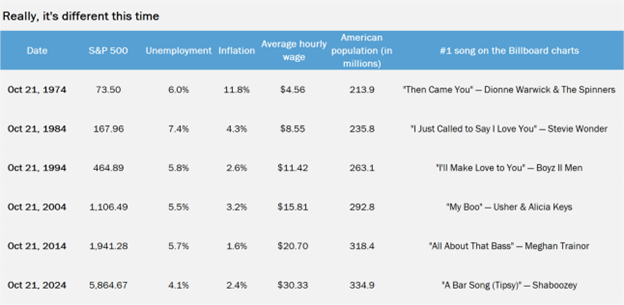There are four words that strike fear into the heart of every Wall Street Brad, Chad, and Thad: “This time is different.” But Wall Street has a lot of silly rules, and the stigma around saying “this time is different” is among the silliest, writes Callie Cox, chief market strategist at Ritholtz Wealth Management.
This phrase is rooted in good intentions. Sir John Templeton – a brilliant investing mind and the namesake of Franklin Templeton – called it “the four most costly words in the annals of investing,” referencing investors’ tendencies to never learn from their mistakes. Humans are gonna human, so be aware of your humanity.
But in my decade-ish of pulling data and poking holes, I’ve realized something important. There’s a thin line between respecting history and ignoring its most significant feature: Change.

We’re all quick to admit how much things have changed in our own lives these past few years. Why can’t we contextualize change on Wall Street like we do on our own street?
Wall Street’s favorite argument right now is that the economy is close to a recession. The shape of the bond market’s yield curve, the unemployment rate, the manufacturing sector, consumer confidence, the leading economic indicators index. We look at our data, and conclude that the economy is indeed weakening because a bunch of reliable lines that fell around past recessions are falling again.
Are those lines reliable, though? Think about this: The last non-pandemic recession started 17 years ago. Obviously, a lot has changed in the past 17 years. Big tech companies took over the stock market, the iPhone nuked our attention spans, Taylor Swift went through most of her eras, and Amazon delivery opened up a world of consumption we never knew we needed.
Now, imagine that change compounded over several decades. In 1960, Americans spent over half their money on goods – TVs, clothes, watches, jewelry. Now, their budget is 70% services – rent, haircuts, travel, streaming subscriptions. As a result, manufacturing jobs now make up just 8% of all employment, down from nearly 30% over the same period.
In the past, manufacturing’s woes have been a clear warning sign of trouble ahead. Today, not so much, because…this time is different *gasp.*
People are spending more on experiences, and the decline in manufacturing hasn’t triggered a wave of job losses. The economy has held up, and you’ve missed a 40% rally in the S&P 500 if you sold your stocks when manufacturing plummeted.
Why do we struggle with change? To me, it’s because Wall Street doesn’t do well in grey areas. But as an investor, you have to be able to live in the grey – constantly challenging your assumptions while remembering certain things will never change. Or, you know, invest on a consistent schedule no matter the conditions.































